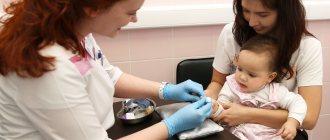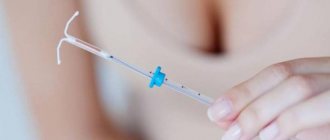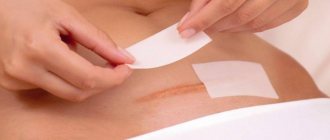What temperature is considered normal for a nursing mother?
A woman who monitors her body temperature during pregnancy may notice that after childbirth, it changes: the thermometer begins to show 1–1.5°C higher. This is physiological and is associated with the arrival of milk, so mommy should not be scared and take action. Jumps in body temperature occur even during feeding: usually before feeding, the readings on the thermometer are higher than after feeding or pumping.
Breast milk is a substance with pyrogenic (temperature-raising) properties. The more it accumulates in the thoracic ducts, the higher the temperature will be. And if the thoracic ducts are damaged or infected, the temperature rises to 39°C.
To find out the exact temperature of a nursing woman, the measurement should be taken no earlier than half an hour after feeding. The norm is 37–37.1 degrees. During feeding, the normal value increases to 37.4°C.
In the first month after childbirth, women experience breast pain, and sometimes the pain is accompanied by low-grade fever. If there are no seals, do not worry - during this period the chest canals expand, which causes pain.
Causes of low body temperature after childbirth
A drop in temperature after childbirth is rare, but it worries mothers no less. In approximately 6-8% of women in labor, the temperature drops to 35.5°C on the 6th day after birth due to anemia or postpartum thyroiditis (dysfunction of the pituitary gland), which provides hormones to the thyroid gland.
Rarely does thyroiditis develop into hypothyroidism. It will not be superfluous to take a general blood test and a blood test for thyroid hormones, namely TSH. If blood tests are normal, most likely the decrease in body temperature is due to the temporary physiological state of the woman; treatment in this case is not required.
What does elevated temperature indicate during lactation?
Elevated temperature during feeding may have the following characteristics:
- Physiological.
- Pathological.
The physiological process is associated with the production of milk by the mammary glands.
Doctors consider a temperature above 37.6°C to be pathological, which lasts for a long time and is accompanied by other symptoms of illness.
The most common sign of fever immediately after the birth of a baby is complications during childbirth:
- suture dehiscence after cesarean section or episiotomy;
- endometritis;
- postpartum thrombophlebitis;
- stagnation of milk (lactostasis) in the mammary glands.
The postpartum period is considered critical, because a woman goes through a difficult journey, which is fraught with a lot of complications. Open birth canals, ruptures, hormonal shock - this is a list of not all dangerous conditions. Any of them allows the infection to easily penetrate the mother’s body, so the temperature of a nursing woman is one of the important markers of her health status.
Childbirth often begins a series of various inflammations: endometritis, mastitis. This list also includes postpartum thrombophlebitis
- inflammation of the venous wall, as a result of which blood clots form inside the vessel. This is a very serious postpartum complication, the marker of which is temperature and corresponding symptoms.
Some time after birth, the cause of fever can be:
- mastitis;
- pyelonephritis;
- colds. Find out what a nursing mother should do if she has a cold.
Fever often accompanies a cough, runny nose, and sore throat. Colds are the most common cause of high fever.
This is followed by stagnation of milk in the breast (lactostasis). Lactostasis differs from mastitis in the absence of swelling and hyperemia of the mammary gland. Once the outflow is restored, fever and pain disappear without treatment. Lactostasis is a common phenomenon and without treatment can lead to a more serious complication – mastitis. In this case, the temperature rises greatly (up to 38°C and above) and there is no relief from expressing milk.
The main symptom of mastitis is the presence of a painful lump in the breast and redness of the skin over it, which is accompanied by an increase in temperature to 38 °C. If you do a blood test, the ESR will be increased and the leukocytes will be increased. There is severe intoxication with malaise and headache. Without treatment, purulent mastitis develops.
Actions when the temperature rises
What to do if a young mother suddenly develops a high fever after childbirth and her general condition worsens? First of all, it is necessary to identify why the malaise occurred. You need to measure your body temperature at the elbow to get real readings. If you feel chills, pain, weakness or nausea, you should urgently call an ambulance.
High fever may also be present when an infectious or viral disease develops.
If you have a fever after giving birth accompanied by a cough or nasal congestion, a sore throat or earache, you most likely have a viral infection.
Remember that any increase in body temperature indicates health problems. If you have already returned home after giving birth and your temperature rises above 37 degrees, you should immediately consult a doctor.
A sharp increase in temperature above 37 degrees with accompanying symptoms of the inflammatory process requires immediate hospitalization in order to identify the source of inflammation and prescribe adequate treatment.
The postpartum period can be a difficult time for many women. The young mother’s body has not yet recovered from pregnancy and childbirth. The immune system is weak. For this reason, you need to carefully monitor your health. To avoid the development of postpartum complications, follow all the doctor’s recommendations, take special vitamins, get plenty of rest and do not neglect walks in the fresh air. In this case, your immune system will reliably protect you from various infections, which means that you and your baby will be absolutely healthy.
Temperature during breastfeeding: to reduce or not?
When the temperature rises, a nursing woman may be concerned about the following questions:
- Is it possible to continue feeding;
- Is the quality of milk deteriorating?
- Are pathogens that get into milk dangerous?
Previously, fever against the background of ARVI served as a reason to stop lactation. It has now been proven that there is no need to stop feeding, because with milk the baby receives antibodies that protect the child. However, mothers need to take a number of precautions:
- wear a mask;
- to wash hands;
- ventilate the room;
- Lubricate the child’s nose with any safe ointment to mechanically delay viruses.
The temperature during ARVI should be lowered if it is above 39 °C - this makes feeding difficult.
Should know
,
that increased temperature does not affect the quality of milk
.
During purulent processes, various pathogenic bacteria enter the blood. In this case, lactation must be stopped, despite the temperature numbers. You also cannot do without a course of antibiotics. Their intake limits lactation.
With lactostasis, feeding is not stopped. On the contrary, it will help to cope with it: by placing the baby on the sore breast, we improve the flow of milk. As a result, the temperature will decrease on its own without the use of drugs.
How to reduce the temperature of a nursing mother?
When deciding to lower the temperature, you need to consider the following factors:
- Temperature level and condition;
- A disease that causes fever.
Reducing the temperature is not a treatment, since we are only fighting the symptom. Reducing the temperature with the help of medications does not mean recovery at all, which is why it is much more important to know the cause of the fever.
If the cause of fever is ARVI with a temperature above 39 °C, it is recommended to gradually reduce the temperature. If the genesis is unclear, it is dangerous to do this; you need to see a doctor and get tested. With proper treatment, the temperature will decrease on its own.
You can start to bring down the temperature by drinking plenty of natural warm juices from raspberries, viburnum, honey and lemon. Rubbing with a vinegar solution or applying cool compresses to the forehead will also help.
Of the medications, nursing mothers are allowed two non-steroidal anti-inflammatory drugs - Ibuprofen and Paracetamol. Read more about Paracetomol during breastfeeding for fever.
Panadol and Tylenol, familiar to many, are also Paracetamol. When taking them, it is important not to exceed single and daily doses, as this can negatively affect hematopoiesis and liver function.
Ibuprofen is the active ingredient in the more familiar drugs Nurofen, Advil, Brufen.
It is extremely important to follow the dosage. The dose of Paracetamol should not exceed 2 grams (0.5 g 4 times a day). The course is short – 2-3 days. If the fever persists, then the cause of the fever is not a cold. In this case, you need to consult a doctor.
Lyubov Maslikhova, general practitioner, especially for
In what situations should you consult a doctor?
The first days after childbirth, the young mother is in the maternity ward under the supervision of medical personnel. If the temperature rises during this period, it is enough to notify the doctor or nurse on duty. You may have to take a few extra tests, but you will be sure that no serious pathology is developing.
A temperature of 38° is considered normal for a woman in labor during the first 24 hours without the presence of additional symptoms such as chills, pain, etc. If the temperature continues to remain at this level further, this indicates the emergence of a focus of the disease.
After discharge, you should visit a doctor if there is a significant increase in temperature or pathological symptoms appear. If chills, nausea, combined with fever appear 2-3 weeks after birth, it is necessary to call emergency help - there may be inflammation of the peritoneum - peritonitis, in which delay is dangerous.
If you have symptoms that indicate a respiratory disease, you need to contact your local physician, and use drugs prescribed for small children as antipyretics. Your general practitioner will answer all your questions about why your temperature may rise after childbirth and, if necessary, refer you to the right specialist.
If you are concerned about pain in the lower back or bladder, you should immediately consult a urologist.
If your temperature rises after childbirth, you should never self-medicate, as this can lead to complications such as peritonitis or sepsis. Therefore, you should pay special attention to your health, consult a doctor on time and follow all his recommendations.
Author: Yulia Mosalova, especially for Mama66.ru
Olga Rogozhkina
midwife
A slight increase in temperature after childbirth may occur in many women. This is usually associated with reversible physiological processes in the body. High temperature in the postpartum period can be an alarm that indicates pathological processes in the body. If this condition is not associated with lactostasis, which can be eliminated by expressing and frequently putting the baby to the breast, then you can try to normalize the temperature using rectal suppositories based on Paracetamol and Ibuprofen. If these actions do not give the desired result, it is important to consult a doctor as soon as possible to exclude the development of possible complications.
Mastitis
If a woman has a fever a certain time after giving birth, this may indicate a disease such as mastitis. By the way, it is very common among young mothers. So, it is worth noting that mastitis is a pathology of breast tissue. It is caused by various microbes and bacteria, as well as other pathogenic microorganisms that enter the breast through cracks in the nipple and are carried through the bloodstream. The main symptoms in this case:
- Increased body temperature (up to 38-39 °C).
- Chills.
- Headache.
- And, of course, chest pain.
You also need to remember that in this case the breasts will be slightly swollen and the skin may turn red. The normal flow of milk is also disrupted. The problem can be treated with antibiotics, but in some of the most severe cases, surgery may be necessary.
Metroendometritis
Complications after childbirth in women can also be caused by inflammation of the uterine mucosa. It occurs in case of accumulation of secretions in the mother's body, blockage of the cervix by a blood clot, retention of placenta particles, or during exacerbation of an old disease. In this case, the temperature occurs approximately 2-4 days after birth and remains around 39 °C. At the same time, the woman also feels chills, loss of appetite occurs, and sleep disturbances are observed. On palpation, pain is felt in the lower abdomen. The nature of the discharge changes: it becomes cloudy, smells bad, and its quantity can significantly increase or decrease. The problem can be treated with antibiotics. Sometimes it is necessary to rinse the uterine cavity.
Treatment
When the cause of the fever is identified, the doctor will prescribe treatment. Perhaps these will be antibiotics compatible with breastfeeding and antipyretics (paracetamol, ibuprofen). You can read about actions to take when milk stagnation occurs in the article “Milk stagnation or what is lactostasis.” It may be helpful to see a lactation specialist.
Rest, sufficient drinking and optimal temperature conditions in the room are excellent helpers for a sick mother.
In our culture, it is customary to drink various teas at elevated temperatures. You can read about herbal teas after childbirth at the link provided. Caffeine is limited as during pregnancy.
The ideal drink would be plain water, weak tea, and soups.
Healing drink that reduces fever after childbirth
You can supplement bed rest and taking medications with a warm drink with honey, lemon and raspberries.
However, you should not drink large quantities of liquid, as it will cause congestion of the mammary glands. During the day, a nursing mother can drink no more than 3 glasses of drink with raspberry jam. The use of herbal infusions should also be approached with caution, since some components of medicinal preparations can cause allergic reactions in infants. If you cannot cope with your temperature within a few days, you should no longer put off visiting a doctor. Based on the clinical picture, the specialist will prescribe special medications that are compatible with feeding the baby.
What to do if the temperature rises after childbirth?
It is not recommended to lower the temperature until it exceeds 38.5°C - the body needs to be given time to fight the disease and produce its own interferon. You should give up household chores for now. Bed rest will be useful now, but wrapping yourself in a warm blanket is not advisable, just like being in a stuffy room - the room should be cool.
Vinegar rubdowns help reduce high temperatures. To do this, vinegar is diluted in half with water and the resulting solution is treated with elbow and knee bends, neck, and groin folds.
Among medications, you can take Paracetamol - an approved drug during breastfeeding. You should not drink Aspirin, as it passes into milk and has a negative effect on the child’s body. In addition to the use of Paracetamol, rectal administration of suppositories containing ibuprofen is allowed during lactation.
Other problems
If a woman has a temperature of 38 °C after childbirth, this may indicate one of the following diseases:
- Thrombophlebitis. In this case, the woman’s veins become inflamed, which leads to their blockage with blood clots. It is worth noting that this disease provokes metroendometritis, described above. Body temperature may increase two weeks to a month after the baby is born. This phenomenon is accompanied by chills, as well as swelling of the legs.
- Pelveoperitonitis. This is inflammation in the pelvis of the abdominal wall. The temperature can even rise to 41-42 °C. Other symptoms: nausea, vomiting, severe pain in the uterine area, chills. The woman's condition is rapidly deteriorating.
- Parametritis. This is an inflammation of the fatty tissue around the uterus. Temperatures can also rise to around 40 °C. There may be chills, nausea, vomiting, and pain during bowel movements and urination.
In any case, we must remember that if you have the slightest doubt, it is best to immediately seek doctor’s help. After all, if you detect a problem earlier, you can deal with it in a shorter time.











